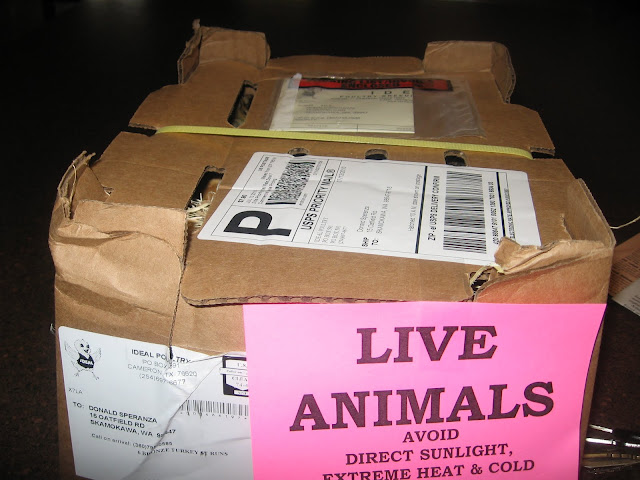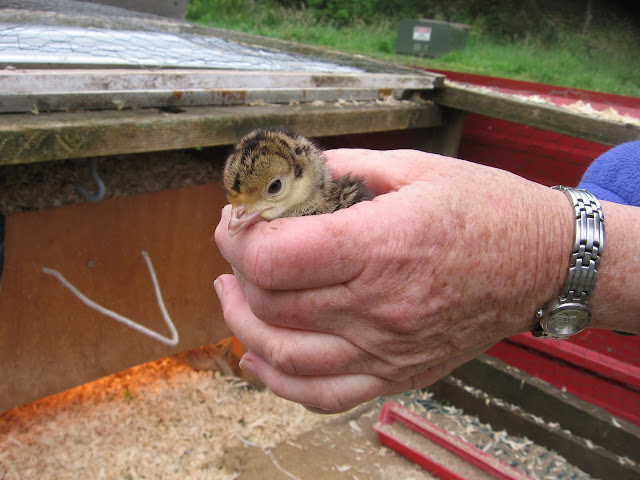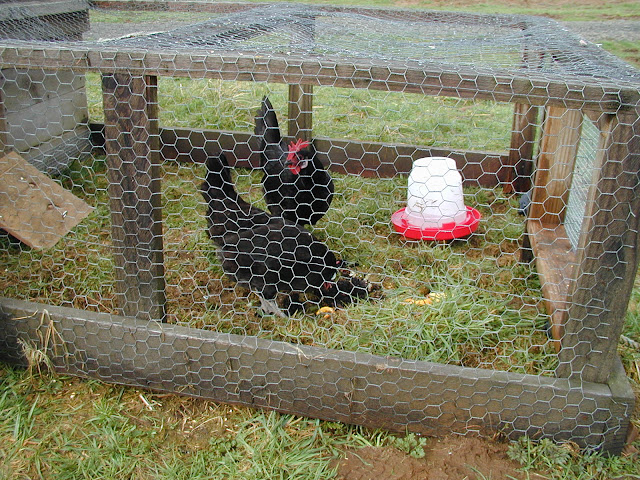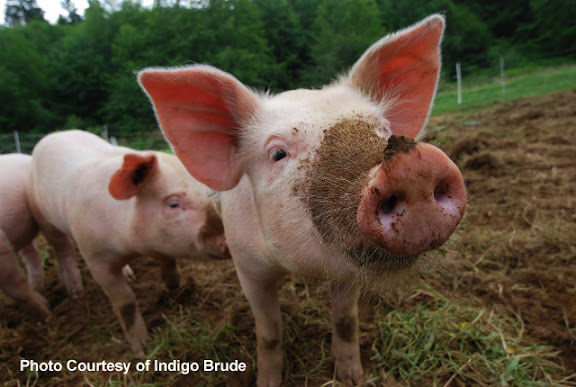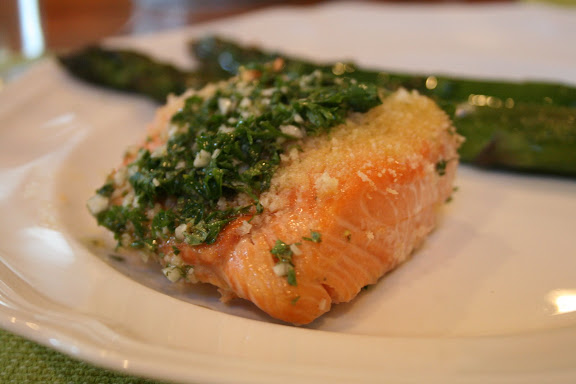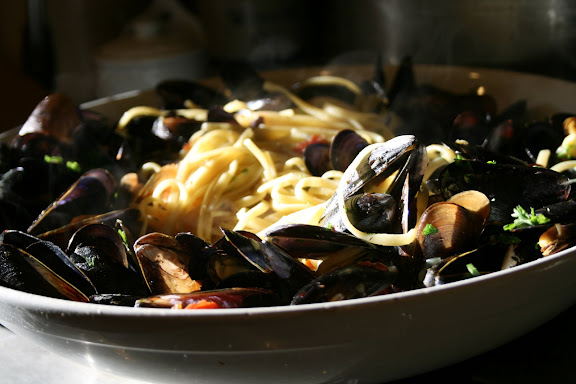Now that we have managed to get through most of the winter storm clean up, I hope to get back to writing about more enjoyable things such as food. So let's catch up on what we have been cooking and serving at the inn lately.
CRISP ROSEMARY FLAT BREAD Gourmet, July 2008
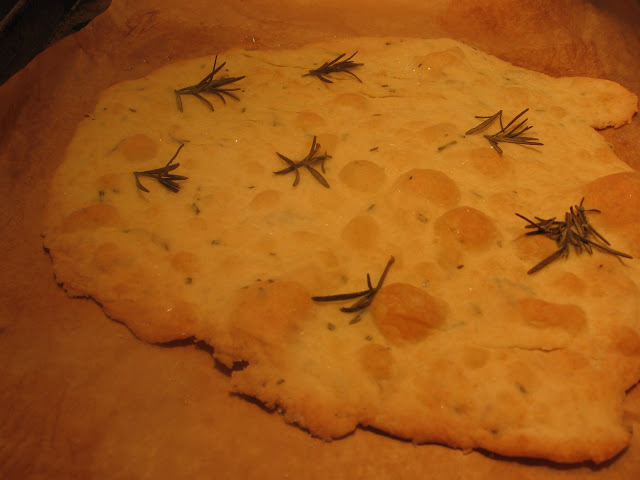
This is really more of a cracker than a bread. It's a great alternative to bread and far better than any crackers you can buy in a store. What's more it's really simple to prepare.
8 3/4 oz of flour (1 3/4 cups)
1 Tablespoon of chopped fresh rosemary (plus 2 sprigs)
1 teaspoon of baking powder
3/4 teaspoons of kosher salt
1/2 cup of water
1/3 cup of extra virgin olive oil (plus more for brushing on)
Coarse sea salt or kosher salt
Preheat oven to 450 degrees.
Stir together flour, chopped rosemary, baking powder and salt in a medium bowl. Make a well in the center and pour in the water and olive oil. Gradually stir into the flour with a wooden spoon until a dough forms. Turn dough out on to a floured work surface and knead gently 4 or 5 times.
Divide the dough into 3 pieces and roll out 1 piece into a 10 inch round. The shape should be rustic and the dough should be thin.
Place the dough on a baking sheet lined with parchment. Lightly brush the top with additional olive oil and scatter small clusters of rosemary leaves on top, pressing them into the dough. Sprinkle with sea salt or kosher salt. Bake until golden and browned in spots, for 8-10 minutes. Cool slightly on a wire rack and break into pieces to serve.
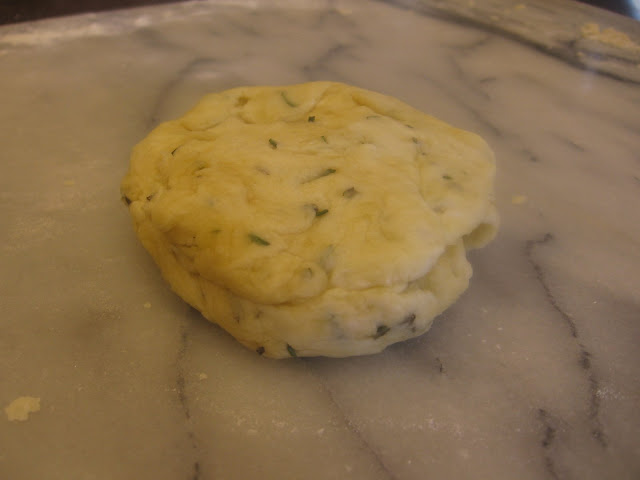
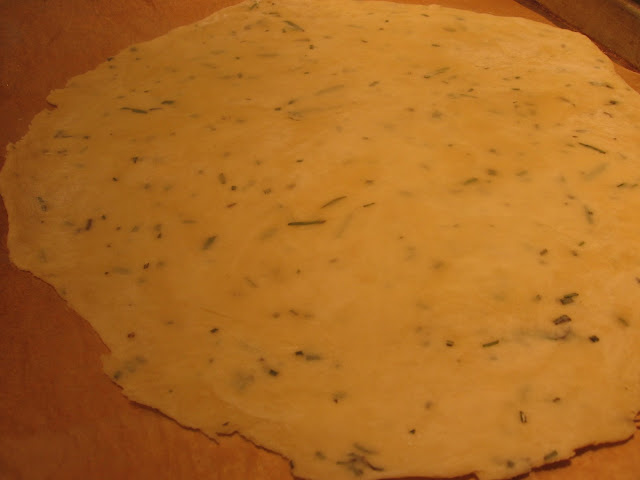
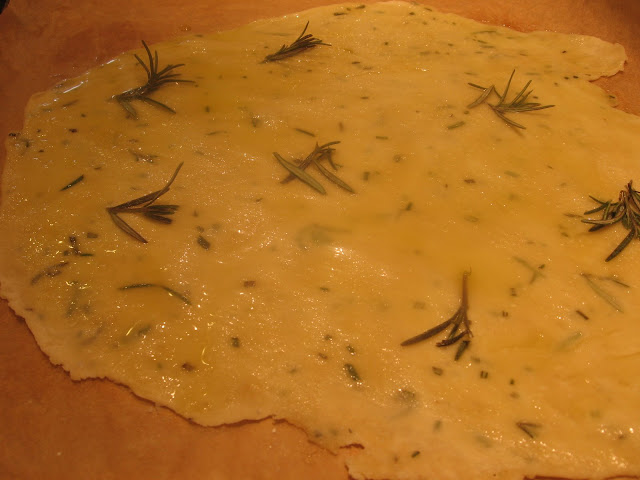
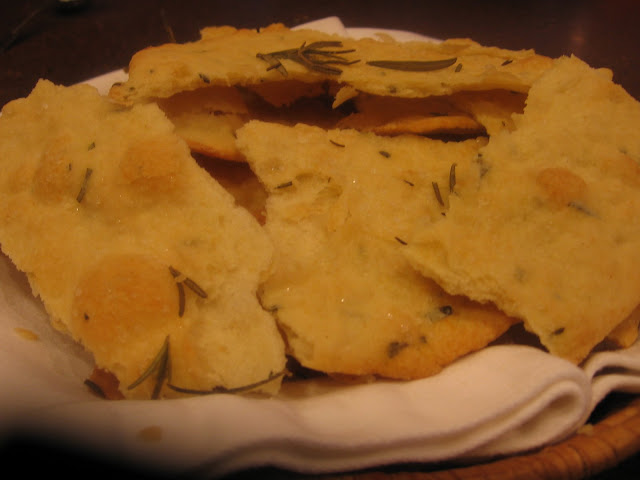
From that same issue of Gourmet comes this great accompaniment.
GOAT CHEESE WITH OLIVES, LEMON AND THYME
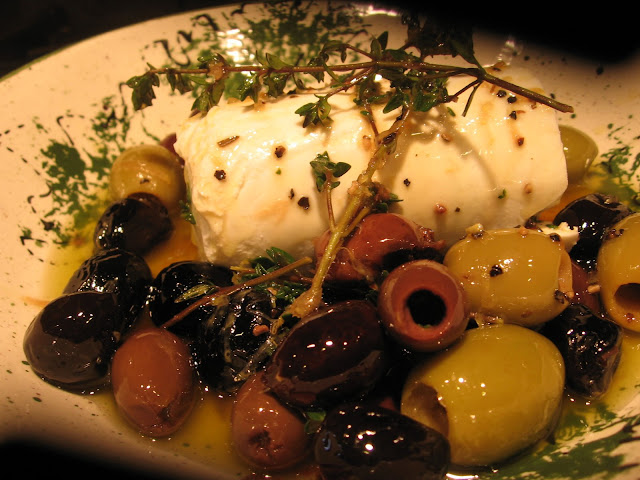
1/2 cup of assorted olives
3 sprigs of fresh thyme
3 Tablespoons extra virgin olive oil
1/2 teaspoon grated lemon zest
4-5 oz medallion of fresh goat cheese
heat olives, thyme, oil, lemon zest and pepper in s small saucepan over low heat just until fragrant. cool to room temperature, pour over the goat cheese and serve with crisp rosemary bread.
One of my favorite dishes to serve in the winter is osso buco. The classic preparation of this dish calls for veal shanks slowly braised with vegetables, wine and broth. Given the high cost of veal these days and the difficulty in finding humanely raised veal, we decided to substitute one of our pasture raised chickens. Since our chickens have firmer muscle and a little more chew than a supermarket chicken, they are a perfect candidate for the slow braising process, and the flavors married beautifully. The meat just falls off the bone.
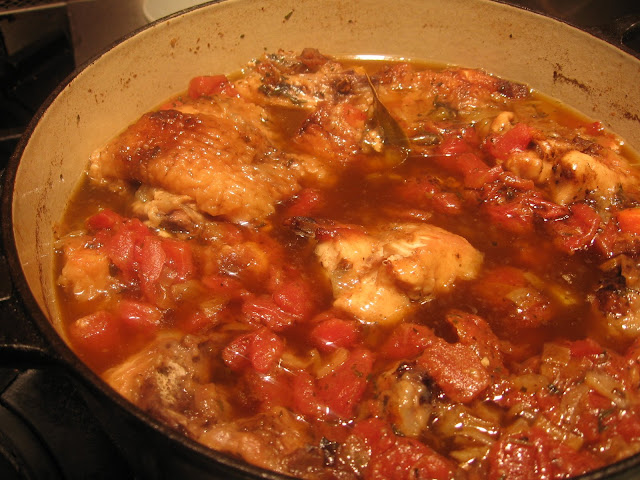 CHICKEN OSSO BUCO
CHICKEN OSSO BUCO1 cup finely chopped yellow onion
2/3/cup finely chopped carrot
2/3 cup finely chopped celery
¼ cup butter
1 teaspoons finely chopped garlic
2 strips lemon peel
½ cup olive oil
8 chicken thighs (preferably with bone in)
1 cup all-purpose flour
1 cup dry white wine
2 cups chicken broth
1 ½ cups canned tomatoes coarsely chopped, with their juice
¼ teaspoon dried thyme
½ teaspoon dried basil
2 bay leaves
Salt and pepper
1. Preheat the oven to 350 degrees
2. Saute the onion, carrot and celery in the butter and 1 tablespoon of olive oil
About 8-10 minutes…until soft. Remove them from the pan and set aside in a bowl.
3. Dredge the chicken in the flour with salt and pepper. Heat the remaining oil in the pan and when it is quite hot, brown the chicken pieces in the oil on both sides.
4. When all the chicken is brown, remove them from the pan and drain off most of the fat. Add the wine and boil briskly for 3 minutes scraping up any browned bits from the bottom of the pan.
5. Return the vegetables to the pan and set the chicken pieces on top, add the broth, tomatoes and spices and lemon peel. If you are using canned broth, hold off on the salt until after cooking. The liquid should come up to the top of the chicken. Add more broth if necessary.
6. Bring the contents of the casserole to a simmer on the stove top. Cover tightly and place in the lower third of the preheated oven. Cook for about 2 hours, carefully turning and basting the chicken pieces every 20 minutes. When done, they should be very tender when pricked with a fork, and the sauce should be dense and creamy. If the sauce seems to thin when the chicken is done, remove the chicken to a warm platter, place the uncovered casserole on top of the stove, and over high heat briskly boil the sauce until it thickens. Pour the sauce over the veal and serve piping hot.
Risotto Milanese would be a good choice to serve with this as is a POLENTA WITH BUTTER AND CHEESE, which is what we chose to do.
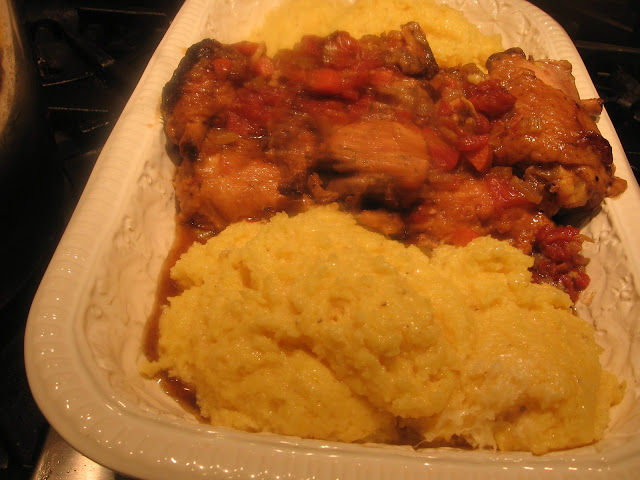
2 cups coarse-grained cornmeal
1 tablespoon salt
¼ lb. butter
8 Tablespoons grated Parmesan cheese
Bring 7 cups of water to a boil in a large heavy pot.
Add the salt and turn the heat down to medium low so that the water is just simmering, and add the cornmeal in a very thin stream, stirring with a wooden spoon. Keep the water at a slow, steady simmer while stirring.
Continue stirring for 20 minutes after all the cornmeal has been added. The polenta is done when it tears away from the sides of the pot as you stir. Remove from the heat and stir in the butter and cheese.
Adapted from THE CLASSIC ITALIAN COOKBOOK by Marcella Hazan
A new recipe from Bon Appetit was the perfect ending for this meal
COFFEE CARAMEL CREME BRULEE
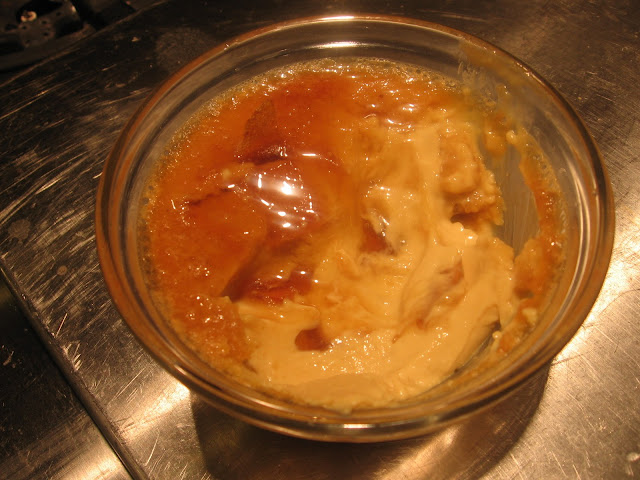
2 cups heavy whipping cream, divided
1/4 cup dark-roast coffee beans (such as French roast; about 3/4 ounce), crushed with mallet in plastic bag
1 cup sugar, divided
1/2 cup water
2 cups half and half
8 large egg yolks
1/4 teaspoon salt
Bring 1 cup cream and coffee beans to simmer in heavy small saucepan. Remove from heat; cover and let steep at least 20 minutes and up to 1 hour.
Preheat oven to 325°F. Stir 2/3 cup sugar and 1/2 cup water in heavy medium saucepan over low heat until sugar dissolves. Increase heat to medium-high and bring to boil, brushing down sides of pan with wet pastry brush. Boil without stirring until syrup is deep amber, swirling pan occasionally, about 11 minutes. Remove pan from heat. Add remaining 1 cup whipping cream (mixture will bubble up). Stir over low heat until caramel is smooth. Stir in half and half. Strain coffee-infused cream into caramel cream; discard coffee beans in strainer.
Whisk yolks, salt, and remaining 1/3 cup sugar in large bowl to blend. Gradually whisk in cream mixture. Strain custard into large measuring cup.
Arrange eight 2/3- to 3/4-cup ramekins or custard cups in roasting pan. Divide custard among ramekins. Add enough warm water to roasting pan to come halfway up sides of ramekins or custard cups.
Bake custards until just set in center, 30-40 minutes. Transfer custards from water bath directly to refrigerator. Chill uncovered until cold, at least 3 hours and up to 1 day.
Usually I caramelize the top by sprinkling sugar on them and heating them with a blow torch or under the broiler of the oven. I used a different technique that I have come to prefer.
Stir 1/2 cup of sugar together with 3 tablespoons of water. Heat and stir until the sugar is dissolved and the syrup comes to a boil. Stop stirring and allow it to boil until it turns a deep amber color. Remove from the heat pour about 1/2 tablespoon on to each custard. It will turn into a shiny glass-like caramel.
